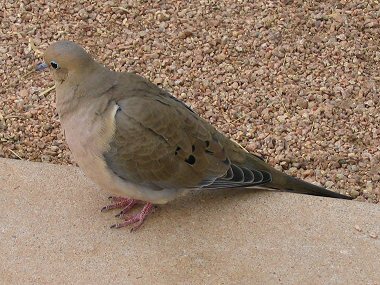Mourning Doves are found throughout North America, and are about
the most common bird you'll see in Arizona, where they can be found rear-round.
They eat a wide variety of seeds, grain, fruit and insects. They prefer seeds
that rest on the ground, though occasionally, they eat in trees and
 bushes
when the ground foods have become scarce. Most of the diet relies on seeds or
plant parts (95%), though on rare occasions, doves can also be seen preying on
grasshoppers, ants, beetles, and snails. bushes
when the ground foods have become scarce. Most of the diet relies on seeds or
plant parts (95%), though on rare occasions, doves can also be seen preying on
grasshoppers, ants, beetles, and snails.
|
When Mourning Doves take off they clap
their wings to get off this ground, producing a distinctive flapping
noise. |
Mourning doves are monogamous during the breeding season and
some of these pairs stay on as couples thru the winter. After finding a mate,
the male initiates the nest selection site. Nest construction takes over ten
hours and covers a span of three to four days. The nests tend to be flimsy
affairs and sometimes the eggs or hatchling falls right through. The female
generally lays two small, white eggs and incubation lasts 14 to 15 days. Both
the male and the female share incubating and the feeding of the babies.
Mourning doves have the longest breeding season of all North American birds.
They can often have three broods in one season. |

